Celebrating our Centennial: NIST Measures the Airwaves for a Century
At the very beginning
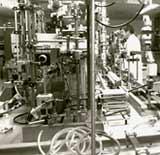
NIST's work in radio research traces back almost to its founding in 1901. The first researcher in radio was Dr. Louis W. Austin who, in 1904, began to investigate the practical application of radiotelegraphy for the Navy. He headed the U.S. Naval Radiotelegraphic Laboratory at NIST from 1908 to 1932. In 1907, J. Howard Dellinger came to NIST as the agency's wireless expert, heading a section in the Electrical Division called Radio Measurements. One of his first measurements, in 1911, was the calibration of a frequency meter. Frederick A. Kolster, a radio engineer, came to NIST in 1911 and developed a portable instrument to measure wavelengths and other properties of radio transmissions. NIST received its first special appropriation from Congress for radio research in 1915--$10,000 "for the investigation and standardization of methods and instruments employed in radio communication."
Training the troops
During World War I, NIST trained thousands of soldiers in radio communication for the Army Signal Corps. It developed a reference book for radio instructors for use in the Army, Navy and universities. Frequent updates and reprints made this reference book a bible for radio engineers and amateurs for two decades. Kolster also developed a radio direction finder for locating enemy submarines. This direction finder was later adapted as a crude aid in airplane navigation. Also during the war, NIST developed methods for measuring the characteristics of the new vacuum tube that was beginning to be adopted by radio manufacturers.
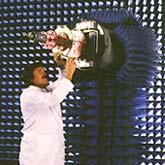
Radiating through the Jazz and Swing Ages
The early days of radio broadcasting in the 1920s were somewhat messy. Commercial stations did not always stay on their assigned frequencies and tended to drift, causing interference with other stations' signals. In 1923, NIST began broadcasting precise frequency signals over its laboratory transmitter WWV in Washington, D.C. Commercial stations could use WWV's frequencies as calibration standards to keep their own frequencies constant. The early NIST station also transmitted music and market and crop reports; but these were only done experimentally and soon disappeared. Precise frequency information is still available on WWV, now located near Fort Collins, Colo. Time information was added to the WWV format in 1945. In addition to WWV, NIST operates two other time and frequency radio stations - WWVB near Fort Collins, and WWVH in Hawaii. Today's customers still include radio (and television) stations but also include electrical power and telecommunications companies, the financial community, scientists and engineers, computer networks, and navigators.
NIST also helped the fledgling radio industry in other ways in the 1920's. It issued a handbook that showed thousands of Americans how to build their own radio sets. And, it built the first alternating-current radio set in 1922, years before commercial firms offered ac-powered radios for the home (earlier models were battery operated). It helped train radio technicians, published early reference works, and coordinated the writing of an academic textbook that was admired by Thomas Edison as "the greatest book on this subject that I have ever read."
A beacon during the Depression
In the 1930's, NIST was perhaps best known for developing radio aids for the airplane industry. Much of the work started when Harry Diamond came to NIST in 1927. He developed the first visual-type radio beacon that enabled a pilot to keep on course and know his approximate position at all times while in flight. Later, Diamond added a unit to the radio beacon that enabled the first blind landing of an airplane entirely by radio guidance. Diamond operated the radio himself in the first series of blind landing tests between College Park, Md., and Newark, N.J. Because of the Great Depression, radio research at NIST was curtailed in the 1930's and centered on audio frequency standards, radio wave propagation phenomena, and measurements of the ionosphere for long-distance radio transmission. Working for the Weather Bureau, NIST scientists developed radiosondes--balloon-borne instruments which transmitted weather data to the ground from altitudes up to 20 miles. By 1940, some 35,000 radiosonde units were being built and sent aloft.
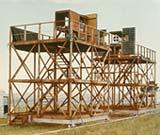
World War II brings bats and fuzes
During World War II, NIST's radio research programs were perhaps best known for developing the radio proximity fuze that enabled shells or bombs to be more effective. The radio proximity fuze is essentially a tiny radio sending and receiving device about the size of an ordinary light bulb. It continuously sends out radio waves; when these waves approach a sizable object, they reflect back to the fuze. As the waves intensify, they trigger an electronic switch that detonates the fuze and the weapon. In another project, NIST helped to develop a radio-operated guided missile called the Bat; it was used by the Navy late in the Pacific campaign. The radio direction finder, first designed by Kolster in 1915, was updated in World War II to detect German submarines. NIST's work on the characteristics of radio wave propagation led to the formation of the Interservice Radio Propagation Laboratory (IRPL) at NIST in 1942. In another radio-related project, NIST developed a quartz crystal inspection and testing laboratory to determine the best quartz to be used in military radio and electronic equipment.
Post-war frequencies become clocks
After the war, the IRPL evolved into the Central Radio Propagation Lab (CRPL). A significant part of the ionospheric and propagation studies depended on having accurate frequency standards in the high frequency range. These were based on special quartz crystal oscillators which constituted the national primary standard of frequency. Before long, the expansion of radio technology into higher frequencies involved the CRPL in developing measurement techniques for microwaves, and in 1949, this expertise was employed in developing the world's first atomic clock. Based on using the absorption of microwaves in ammonia gas to stabilize the frequency, this clock was only slightly more accurate than the spinning earth, but it quickly led to other clocks based on a resonance in cesium atoms, and which far exceeded the accuracy of any previous timekeeping system. The latest version (the eighth generation, called NIST F-1,) of these cesium clocks attains an uncertainty of better than 2 parts in a million billion (comparable to 1 second in 20 million years).
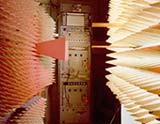
A move to Colorado in the '50s
The CRPL, which moved to Boulder, Colorado, when the NIST laboratories there were opened in the early 1950s, was later divided and part became the National Oceanic and Atmospheric Administration's Environmental Research Laboratory and the National Telecommunications and Information Administration's Institute for Telecommunication Sciences. The part that stayed with NIST became the Electromagnetics Division of NIST (now the Radio Frequency Technology, Electromagnetic Technology, Optoelectronics, Magnetic Technology and Time and Frequency Divisions).
These have continued their research efforts in support of industry, with the development of advanced measurement techniques for microwave parameters, antenna performance, lasers, optical fibers, magnetic data storage, time transfer, and numerous other technologies.
Taking measurements in the near-field
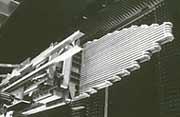
Of crucial importance to many radar and microwave communications manufacturers is the near-field/far-field microwave antenna measurement technique invented and developed by NIST. It permits the accurate evaluation of antenna performance at far less cost than previous methods. Until this development, the radiation and gain patterns of antennas were difficult and expensive to characterize, as they required measurements at large distances. Often it was necessary to fly a planeload of instruments through the far-field pattern many times in many directions before an adequate picture of the pattern emerged. Engineers, physicists and mathematicians of the Electromagnetics Division developed techniques to calculate complete three-dimensional far-field patterns from measurements made close to the antenna or electronically steerable array. This means the measurements can be made conveniently in the laboratory for many antennas, and eliminates the problem of transporting instruments over large areas. The near-field data are fed to a computer, which uses a new and rigorous mathematical approach to transform them into far-field predictions. The results can then be machine-plotted in the form of maps, graphs, or tables of values. The technique permits economical solutions to problems that sometimes couldn't even be attacked before, and is often more accurate than actually making the measurements at a large distance. Near-field measurement ranges based on NIST's technology have been built at dozens of manufacturers and defense installations.
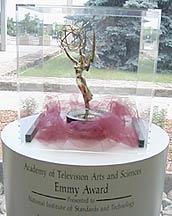
Other microwave innovations based on NIST's work are the automatic network analyzer and 6-port. They enable rapid, accurate measurements of a suite of important parameters in microwave equipment and components.
Laser measurements lead into new century
Laser performance measurements have been made at NIST almost as long as lasers have been around. Beginning in the early 1960's, NIST developed techniques for measuring the output power and energy of lasers. Research on measurements and standards to support the development and application of lasers continues. Research related to optical communications was begun in the 1970's, expanded in the 1980's, and continues at a substantial effort today.
In the still-young field of optical fibers, standards of performance and dimensions are still evolving. NIST's work in this area includes methods for determining the core and cladding diameters of fiber, the intensity profile across the face of the fiber, and chromatic dispersion. The Optoelectronics Division conducts over 200 calibrations annually and provides industry with standard reference materials that can be used to calibrate a customer's own instruments.
TV time system leads to an Emmy
In the '70s, NIST developed an experimental television-time-code system to provide inexpensive coarse- and fine-time signals to a great number of users. The code carried information designating the hour, minute, and second, and displayed it on the bottom of the screen. This "TV-Time" technology was the basis for the development of today's "Closed Captioning" system, for which NIST received an Emmy in 1980. Closed captions provide the capability to display the text of television dialog and narration, in any language. This has been a development of great benefit to the hearing impaired and to the patrons of sports bars.

